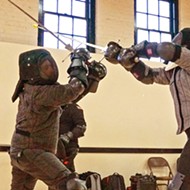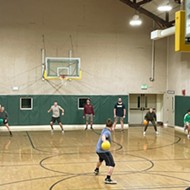Starkly similar: A Cal Poly professor from Mississippi reveals that young people's sexual health awareness isn't so different in California
By Bulbul Rajagopal[{
"name": "Newsletter Promo",
"id": "NewsletterPromo",
"class": "inlineCenter",
"insertPoint": "4",
"component": "15264767",
"requiredCountToDisplay": "0"
},{
"name": "Ad - Medium Rectangle CC01 - 300x250",
"id": "AdMediumRectangleCC01300x250",
"class": "inlineCenter",
"insertPoint": "8",
"component": "2963441",
"requiredCountToDisplay": "12"
},{
"name": "Ad - Medium Rectangle LC01 - 300x250",
"id": "AdMediumRectangleCC01300x250",
"class": "inlineCenter",
"insertPoint": "18",
"component": "2963441",
"requiredCountToDisplay": "22"
},{
"name": "Ad - Medium Rectangle LC09 - 300x250",
"id": "AdMediumRectangleLC09300x250",
"class": "inlineCenter",
"insertPoint": "28",
"component": "3252660",
"requiredCountToDisplay": "32"
}]
Dr. Joni Roberts moved to California from Mississippi believing that sexual wellness awareness among young people on the West Coast would be higher.
"If you're familiar with sexual health in Mississippi, or in the South, in general, it is night and day, from Southern U.S. to the Western U.S.," she said. "In Mississippi, it is state law that any sexual education courses that are taught in K-12 cannot be comprehensive; it has to be abstinence, or abstinence-plus. In fact, teachers could get arrested if they even attempted to talk about safe sex with condoms, and so forth."
An assistant professor in Cal Poly's Department of Kinesiology and Public Health, Roberts runs a sexual and reproductive health lab. After moving to San Luis Obispo County in 2019, she spearheaded a 2020 assessment that studied knowledge and beliefs around sexual health held by Cal Poly students.
Unlike Mississippi, California school districts must teach comprehensive sex education courses at least one time each in middle school and high school. These schools are bound by the state's Healthy Youth Act of 2016, which promotes unbiased and accurate sexual health and HIV prevention education. Roberts had high expectations for the results of such a progressive program.
"It was surprising to me, because I sort of had this bias going in," she said. "What we found is that there's still a lot of misconceptions as far as what students knew. Then there was practice that was different."
Roberts said that while Cal Poly students participating in the study knew theoretically what safe sex entailed, that knowledge didn't necessarily translate to practice. The assessment revealed that students didn't use protection methods—such as dental dams during oral sex—and there was a lack of safe sex conversations between partners. In fact, 43 percent of participating students said that they wouldn't refuse to have sex if their partner refused to use a condom.
Roberts added that the two main themes that cropped up during the study were "cleanliness"—a term participants used to describe STI (sexually-transmitted infection) status—and gender-based differences.
The results of the study prompted Roberts to introduce sex education modules in her lab. On Feb. 9, she'll be joined by kinesiology and public health major Gabriella Snow and biology major Alexa Asson to host a campus sex education seminar as part of the seventh annual Social Justice Teach In workshops.
Roberts described sexual health as everything regarding an individual's body and what they choose to do with it. She's interested in learning more about young people's mindset about it.
"So, whether that is engaging in sexual intercourse—whether that's oral, anal, or vaginal-penile," she said. "What are the thought processes that they sort of go through before they get to a decision? How do they go from being in their home at 2 o'clock on an afternoon, to having sex at 10 p.m. on the same day?"
Other surprising discoveries came as a result of Roberts moving from a racially diverse student population in Mississippi to Cal Poly—statistically the whitest campus in the California State University (CSU) system.
"Something I thought that was unique here within the white population—and I haven't been able to test this in other predominantly white spaces—is there is a complete level of trust that students seem to have," she said.
Roberts—a Jamaican raised in the Caribbean—found herself using the phrase "blind trust" often, especially after her lab followed up with the white students who participated in the quantitative section of the survey.
"It didn't matter how long they were in a relationship with their partner, whether it was a few months or several years," Roberts said. "But there was this assumption that they could not get an STI from their partner because their partner was faithful to them. They believed that wholeheartedly. That's something that I did not experience before, especially among communities of color."
White students, too, seem more confident in their sex lives, Roberts said. Confidence didn't necessarily begin at home either. Roberts said that outside support systems like clubs and organizations, which students could access based on their economic privilege, played a big role in sexual wellness. While she acknowledged that the present generation of young people is more vocal about sex than their predecessors, race and economic issues still exist.
"Especially here at Cal Poly, where we are known as the whitest CSU, it is not uncommon then to have more students of color have more negative experiences," Roberts said. "That's something that was reported: Students felt fetishized by their white counterparts, or they weren't taken as seriously in relationships. Those are their reported experiences compared to their white counterparts."
In Roberts' experience, many students' misconceptions about sexual health centered around the definition of virginity, queer relationships, and lax attitudes toward STIs. Her lab team is also focusing on including the voices of queer and cisgender male students. One of those team members is Anoushka Samuel, a second-year Cal Poly student.
"I think there are so many gaps in our sexual health education right now," said the born-and-raised Californian. "The only time I remember learning about it was a mandatory video we had to watch in the fifth grade, and then again in one of my biology classes in high school but barely touching on STIs."
Samuel specializes in research around menstrual products and their use. She said it's an integral part of understanding sexual wellness, and she advocates for Cal Poly to stock menstrual products in all campus restrooms.
"The use of menstrual products is a good way to gauge cultural differences," she said. "Like the whole thing about whether using tampons means losing your virginity or not."
Roberts attributed the lower-than-expected sexual wellness awareness in California to some loopholes in the Healthy Youth Act. Every school district can choose a different curriculum for sex education. When the time rolls around for a middle or high school to provide that one-time discourse, parents can write in and deny permission for their kid to participate. Then, there's the matter of when the student received sex education.
"Say, maybe I received it in seventh grade, and then I didn't receive it again until 12th grade. Well, by the time it comes back around in 12th, grade, I likely forgot what I learned in seventh grade," Roberts said.
The length of time between each sex education course might also be long enough that students learn from other sources of information.
"I likely may have been experimenting between that time. By the time I get the official education from the school system, I would have already been learning from my peers," she hypothesized. "There'll be people around me who would be engaging in things or telling me things; they would be my primary source of education—not to mention social media, which is very common in this age range." ∆
Reach Staff Writer Bulbul Rajagopal at [email protected].
Latest in News
Readers also liked…
-

Coast Unified teachers upset over new position's salary and qualifications
Oct 20, 2022 -

SLO police identify alleged driver who hit and killed couple
Dec 22, 2022 -

When the levee breaks: Oceano residents, county officials walk a tightrope of regulations to manage Arroyo Grande Creek, which some say led to the levee's failure in January
May 18, 2023














